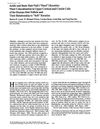TLDR Human nails contain both skin and hair keratins, each needing different extraction methods.
The study investigated the extraction and characterization of keratins from human nails using different concentrations of the reducing agent 2-mercaptoethanol. It was found that nails contained both epidermal and hair keratins. Epidermal keratins were extracted with 50 mM 2-mercaptoethanol, while hair keratins required 200 mM for extraction. This suggested that nails have unique keratin compositions, with differing structural features between epidermal and hair keratins despite their coexistence in nails. The study highlighted the distinct properties and durability of these keratins in the nail structure.
 356 citations
,
December 1986 in “The journal of cell biology/The Journal of cell biology”
356 citations
,
December 1986 in “The journal of cell biology/The Journal of cell biology” Hair and nail cells share similar proteins, indicating a common differentiation pathway.
198 citations
,
October 1986 in “Differentiation”
3 citations
,
November 2022 in “Frontiers in Medicine” Onychopapilloma likely originates from the nail bed, not the nail matrix.
110 citations
,
August 2004 in “British Journal of Dermatology” The ventral matrix is the main source of the nail plate.
25 citations
,
January 2003 in “Plastic & Reconstructive Surgery” Nail-matrical fibroblasts can make non-nail cells produce hard keratin, useful for nail repair.
88 citations
,
June 2000 in “Journal of Investigative Dermatology” Keratin 17 is important for hair and nail structure and affects pachyonychia congenita symptoms.
119 citations
,
January 2000 in “British Journal of Dermatology” Different parts of the nail express different keratins, showing unique patterns of differentiation.
10 citations
,
May 1994 in “Journal of Investigative Dermatology” 23 citations
,
February 1993 in “Journal of Investigative Dermatology” 36 citations
,
December 1991 in “Journal of Dermatological Science” Human nails contain both skin and hair keratins, each needing different extraction methods.
